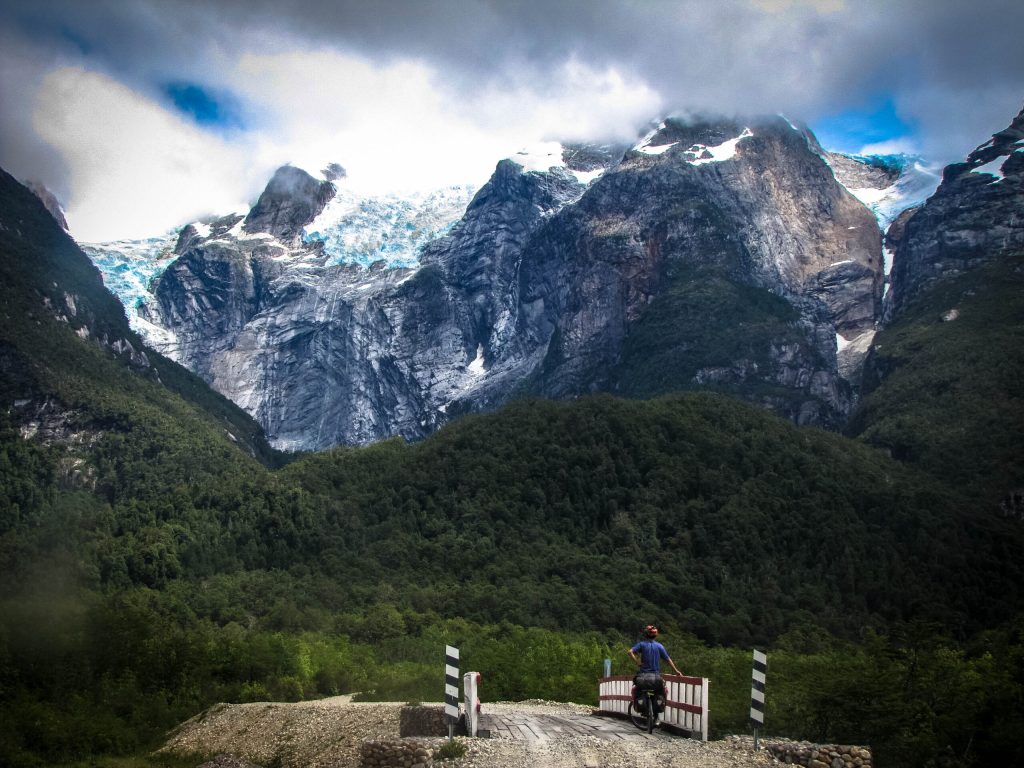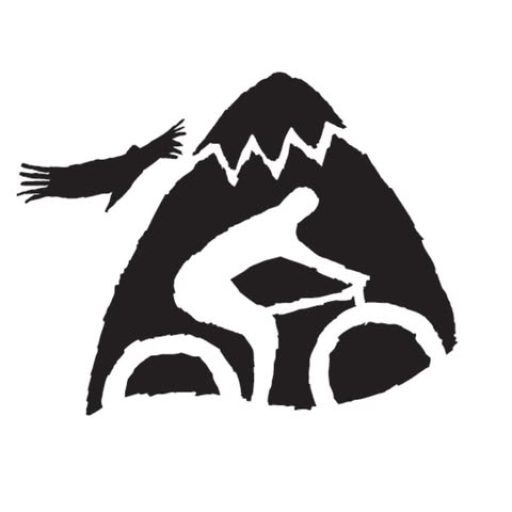
by Fernando Padilla. Co-founder of Cicloaustral Chile.
Demographics, Characteristics, and Trends of Cycle Tourists in Patagonia, Chile
The Carretera Austral is a 1,247-kilometer route stretching through Patagonia, Chile, connecting over 20 remote villages via a mix of 60% paved and 40% gravel roads. It crosses two regions—Los Lagos and Aysén—and has become an iconic journey for adventure cyclists seeking pristine landscapes, cultural richness, and a profound sense of remoteness.
The route’s fame is not accidental. National Geographic listed it in 2010 as one of the top 3 “Journeys of a Lifetime” for cycling. Its appeal has only grown with the 2021 creation of the Route of the Parks of Patagonia, a conservation initiative powered by the Thompkins family—founders of The North Face—who made one of the largest land donations in history to expand Chile’s national parks.
The Carretera Austral is exceptional in its environmental value: over 50% of Chile’s national protected areas are located here. Forests in this region absorb up to three times more carbon per hectare than the Amazon, according to Rewilding Chile and National Geographic (2022). Its high conservation value, low crime, and strong community culture also make it one of the safest and most transformative destinations for slow travel in South America.
Growth in Cycle Tourism
A recent article on our website highlighted the growing number of cyclists using ferry systems to access the Carretera Austral. Nearly 5,000 cyclists rode the route between 2017 and 2024 (Cicloaustral and Chile’s Undersecretary of Transportation, 2024), pointing to a clear upward trend. This growth signals a unique opportunity to promote sustainable tourism and community-based development in Patagonia.
A Groundbreaking Study on Cycle Tourists
To better understand this emerging tourism niche, Cicloaustral partnered with co-founder Fernando Padilla’s master’s thesis research to conduct the most comprehensive study to date on cycle tourists in the Carretera Austral. The study aims to offer actionable insights to communities, local businesses, and policymakers for sustainable tourism development.
Methodology
A post-trip survey was conducted during the 2024 high season (January–March), in both English and Spanish. It was distributed via QR posters in more than 80 bike-friendly hospitality services across the route. A total of 218 cyclists responded, offering a valuable dataset on cycle tourist demographics, preferences, and travel patterns.

Demographics of Cycle Tourists on the Carretera Austral
Age Range of Cycle Tourists

Source: Cicloaustral Chile & Padilla F.V., 2024
- The 30–39 age group is the largest, accounting for 40% of all respondents, suggesting a strong presence of working-age adults who likely value long, immersive travel experiences.
- 21% are in the 18–29 bracket, highlighting younger adventurers, including students and early-career travelers.
- 26% are aged 40–59, showing that cycle tourism appeals to mid-career adults.
- A notable 12% of cyclists are over 60, illustrating that this journey is also accessible to senior cyclists with the physical endurance and passion for remote exploration.
Gender and Trip Partner Correlation
| Attributes | Man | Woman | Chi-square (Pearson) | Significance (p) |
|---|---|---|---|---|
| Within solo partner | 67 (77%) | 20 (23%) | 4.54 | 0.023 |
| Within spouse partner | 43 (61%) | 42 (49%) | ||
| Self-guided | 132 (70%) | 58 (31%) | 21.55 | <0.001 |
| Guided bike tour | 13 (62%) | 8 (38%) |
Source: Cicloaustral Chile & Padilla F.V., 2024
- Men make up 69% of the total respondents, while women represent 31%—a common pattern in long-distance cycle touring globally.
- Among solo travelers, 77% are men, compared to 23% women, suggesting men are more likely to travel alone.
- Conversely, 49% of women travel with a spouse or partner, reflecting a preference for shared travel experiences among female cyclists.
- The vast majority of trips—87%—are self-guided, with a smaller portion (13%) participating in organized or guided bike tours.
Origin of Cyclists by Region

Source: Cicloaustral Chile & Padilla F.V., 2024
- 63% of cyclists are from international destinations, indicating strong global interest in Patagonia.
- internationally Europe leads with 39%, followed by North America (14%) and Latin America countries including Chile (45%), showing the Carretera Austral’s broad geographic draw.
- Chileans represent 37%, highlighting growing domestic cultural interest in exploring their own country in Patagonia and active tourism.
Top 10 Countries Represented

Source: Cicloaustral Chile & Padilla F.V., 2024
- The USA and Spain (7% each) are the most common individual countries of origin, reflecting strong interest in adventure cycling from both North America and Europe.
- France, the UK, and Canada follow closely at 6%, indicating a robust interest from countries with strong cycling cultures.
- Germany accounts for 5%.
- Chile ranks as the top Latin American country, with a solid 37%—demonstrating both growing national awareness and accessibility to domestic travelers.
- The diversity of nationalities reflects the global appeal of the Carretera Austral and highlights its potential as an international destination for sustainable tourism.
Education Levels of Cyclists

Source: Cicloaustral Chile & Padilla F.V., 2024
- Cyclist are very well educated. 50% hold graduate degrees; 45% have bachelor’s degrees.
- High levels of education suggest opportunities for engaging riders in conservation and sustainability practices.
Annual Income
| Annual Income (USD) | Domestic (%) | International (%) | Total (%) |
|---|---|---|---|
| >10,000 | 44 (26.3%) | 15 (14.7%) | |
| 10,000–30,000 | 50 (29.9%) | 20 (19.6%) | |
| 30,000–50,000 | 27 (16.2%) | 24 (23.5%) | |
| 50,000–80,000 | 25 (15.0%) | 23 (22.5%) | |
| 80,000–100,000 | 11 (6.6%) | 11 (10.8%) | |
| >100,000 | 10 (6.0%) | 9 (8.8%) |
Source: Cicloaustral Chile & Padilla F.V., 2024
- Middle-income travelers (USD 10,000–50,000) make up 46% of respondents.
- High-income travelers (>50,000) make up 28%.
- Domestic cyclists report significantly lower incomes than their international counterparts, however, also linked with the young generation of cyclists/ students that travel their own country.
- Nevertheless, long distance cyclist even having high, middle or low-incomes, tend to spend consciously understanding their significant contributions to small and medium local business in rural villages along Patagonia.
Characteristics of the Bike Trips
Trip Features
| Trip characteristics | N | % |
| Bike trip frequency | ||
| First time | 180 | 82,6% |
| Second time | 33 | 15,1% |
| Third time | 1 | 0,5% |
| More than three times | 4 | 1,8% |
| Length (days) | ||
| 4 to 10 | 36 | 16,5% |
| 11 to 15 | 27 | 12,4% |
| 16 to 20 | 33 | 15,1% |
| 21 to 30 | 60 | 27,5% |
| <30 | 62 | 28,4% |
| Daily expenditure | ||
| >USD20 | 62 | 28,4% |
| USD20 to 50 | 127 | 58,3% |
| USD50 to 100 | 24 | 11,0% |
| USD100 to 200 | 5 | 2,3% |
| Type of bike trip | ||
| Self-guided bike trip | 190 | 87,2% |
| Guided bike tour | 21 | 9,6% |
| Both types of trip | 5 | 2,3% |
| Other | 2 | 0,9% |
Source: Cicloaustral Chile & Padilla F. V., 2024
- The bike trip frequency shown in the table reveal that first timers 180 (83%) dominated, whereas second timers embody 33 (15%).
- Trip length both, more than 21 and over 30 days comprise 122 (46%). This fact very impressive thinking about the cyclist contribution due to long stays at the destination.
- Daily expenditure cyclists spending between USD 20 to 50 is by far the main contributors of the destination, however, those who spend less than USD 20 with 127 (58%) that represent the budget trips, hence an important contributor for locals due to long extensions of their trips.
- Type of bike trips, self-guided bike trips 190 (87%) explains the phenomenon of cycling, when just 10% represent guided bike tours.
Travel Companions
| Partner Type | N | % |
|---|---|---|
| Solo | 87 | 39.9% |
| Spouse/Partner | 85 | 39.0% |
| Friends | 53 | 24.3% |
| Family Members | 14 | 6.4% |
Source: Cicloaustral Chile & Padilla F. V., 2024
Solo and pair travel are the most common formats, reinforcing the independent nature of these trips.
Main Starting and Ending Points
| Starting Point | N | % |
|---|---|---|
| Puerto Montt | 95 | 43.6% |
| Puerto Varas | 28 | 12.8% |
| Coyhaique | 20 | 9.2% |
| Villa O’Higgins | 20 | 9.2% |
| Ending Point | N | % |
|---|---|---|
| Villa O’Higgins | 94 | 43.1% |
| Coyhaique | 36 | 16.5% |
| Caleta Tortel | 22 | 10.1% |
Source: Cicloaustral Chile & Padilla F. V., 2024
Trips generally begin in the north (Puerto Montt) and end in the south (Villa O’Higgins), (Coyhaique) also draws important half-way exit of Carretera Austral due to Balmaceda Airport connection and new trend shows how (caleta tortel) positioned as ending point connecting with torres del Paine Destination through navigation ferry.
Services and Preferences
Bicycle and Equipment
| Source of Bike | N | % |
|---|---|---|
| Brought own bike | 172 | 78.9% |
| Rented locally | 38 | 17.4% |
| Bought in Chile | 7 | 3.2% |
Accommodation Preferences
| Accommodation Type | N | % |
|---|---|---|
| Camping | 187 | 85.8% |
| Wild Camping | 141 | 64.7% |
| Hostel/Guest House | 114 | 52.3% |
Source: Cicloaustral Chile & Padilla F. V., 2024
Food and Meals cyclist preferences
- 82% cook their own meals.
- 72% buy snacks/lunches locally.
- 70% eat in restaurants occasionally.
Recreational Activities while cycling
- Hiking (81%)
- Photography/Video (54%)
- Flora & Fauna observation (36%)
- Kayaking, hot springs, and rafting also popular.
Main Challenges and issues along the ride.

Source: Cicloaustral Chile & Padilla F. V., 2024
Cyclists reported as they main issues along the cycling experience in the Carretera Austrral:
- Bad weather (36%)
- Slopes and long distances (33%)
- Mechanical issues (25%)
- Gravel roads, dust, and accidents (18%)
- Language barriers (17%)
- Physical fatigue (10%)
These challenges are also part of the transformative experience of cycling through one of the world’s most remote and majestic regions.
Conclusion
This study offers the most detailed profile to date of who is riding the Carretera Austral, how, and why. It reaffirms that this route is an emerging hub for sustainable, educational, and meaningful travel. Cicloaustral is proud to contribute data-driven insights to support public institutions, bike-friendly businesses, and local communities.
As we move forward, our mission remains clear: to promote sustainable development in Patagonia by bridging the needs of cyclists with the unique culture and environment of the Carretera Austral. Together, we can grow this destination responsibly and inclusively.
